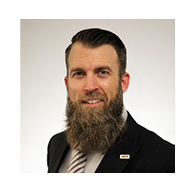Adopting a virtual platform
Determining the right tool for engaging the public in transportation projects
Adopting a virtual platform
By Darin Welch and Erica Blonde - HNTB Corporation
Six years ago, in partnership with Iowa DOT, HNTB began active development of the Public Involvement Management Application (PIMA) to help transportation agencies manage the entire stakeholder outreach process and enhance project decision-making. Our efforts were motivated by three public involvement trends:
- Traditional public engagement methods that use paper comment forms and rely on interested stakeholders to participate at in-person public meetings were becoming less effective.
- We live in a digital world driven by consumer-based mobile experiences, “likes” and the public sharing of opinion. People expect a convenient, inclusive experience.
- Transportation agencies were looking for solutions to establish efficiencies with internal processes and consistent tools that could be leveraged across all projects..
Virtual tools, such as PIMA, address those needs and are becoming a permanent and increasingly popular platform for public engagement. Now adopted by multiple departments of transportation, PIMA is a proven tool that helps public involvement professionals meet critical National Environmental Policy Act (NEPA) requirements and keep critical transportation projects on schedule.
PIMA transforms the management of stakeholder engagement using configurable capabilities to set up and manage project comment forms, responses, correspondence and meetings/events. It provides a consistent, accessible and mobile-friendly means of allowing the public to continually engage. As information rolls in from the public, project teams can easily monitor, analyze and evaluate how to plan and execute engagement strategies for improved conversation and support with the communities that projects impact. Key benefits include:
- Greater public participation. Using PIMA, users can view, comment and digest the data at their own pace, on their own time. Compared to a traditionally scheduled in-person meeting, a DOT is likely to see many hundreds of participants view on-demand, prerecorded online video presentations or log on to live, online presentations.
- Increased transparency that encourages conversation. Getting messaging and information earlier into constituents’ hands enhances a transportation agency’s reputation as open, accessible, proactive and accountable.
- Greater inclusivity. Virtual public meetings are accessible to nearly everyone – no matter where they live, their access to transportation, their income level, ethnicity or ability to speak English.
- Increase productivity. PIMA provides agencies with a fast, simple way to gather and monitor feedback from project stakeholders on one or all of their projects. With a few clicks, PIMA managers can:
- Sort participants feedback by category, tone, source, stakeholder type, date
- Customize comments, response messaging and stakeholder lists
- More efficiently create, distribute and track individual or mass emails and
text messaging campaigns - Create events, send invitations and easily track attendance
- Manage comments and questions through templated and drafted responses
- Stream recorded and live meetings, or share through Esri Story Maps
- Measure the effectiveness of outreach and visualize the results with maps and charts
- Poll your stakeholders with survey participation to assess preference on key issues and objectives, and include map-based interaction like live/work/play
- Customize URLs for virtual events that include meeting registration and question/comment sections
- Earlier agency decision-making. Leveraging PIMA makes it easier for design and project management staff to distribute information earlier in the project’s lifecycle. Meaningful feedback from virtual events empowers project managers and staff to make more informed decisions even in the early conceptual phase. It allows them to gain a sense of the level of support a project may have before the agency invests a significant amount of money in its design.
PIMA uses GIS processes to aide in the ability to measure inclusion and equity. By capturing location with stakeholder feedback, you can assess which portions of your community - including minorities - are engaged and have a voice. Agencies can also configure language translation to distribute project information in Spanish, for example. Communicating with constituents in their language creates a more inclusive process and their input valued.
The future of PIMA
By the end of 2021, PIMA will have new capabilities that make it even easier for statewide audiences to discover projects, get and stay engaged and see what others are saying. In the meantime, using PIMA as a platform for the public involvement process can bring greater transparency to public involvement initiatives when face-to-face meetings aren’t possible or practical. The virtual platform gives DOTs the ability to make more efficient, informed decisions and move their projects forward while promoting inclusivity and convenience.
ABOUT THE AUTHORS:
 Darin Welch is a geospatial virtual engagement manager in HNTB’s Technology Solutions Center. He leads a talented support staff team for many of HNTB’s most significant GIS consulting and asset management projects. He brings substantial knowledge and thought leadership through his strong technical background in geospatial systems integration, technology project management, enterprise GIS implementation and application solutions development. Contact him at [email protected] or (816) 809-8990.
Darin Welch is a geospatial virtual engagement manager in HNTB’s Technology Solutions Center. He leads a talented support staff team for many of HNTB’s most significant GIS consulting and asset management projects. He brings substantial knowledge and thought leadership through his strong technical background in geospatial systems integration, technology project management, enterprise GIS implementation and application solutions development. Contact him at [email protected] or (816) 809-8990.
 Erica Blonde, AICP, is a public involvement lead and environmental planner for HNTB. She brings a diverse background of public involvement experience throughout the northeast and California. Her focus is on using technology to reach historically underserved communities and evaluating outreach strategies using geospatial data. Contact her at [email protected] or (617) 532-2241.
Erica Blonde, AICP, is a public involvement lead and environmental planner for HNTB. She brings a diverse background of public involvement experience throughout the northeast and California. Her focus is on using technology to reach historically underserved communities and evaluating outreach strategies using geospatial data. Contact her at [email protected] or (617) 532-2241.
SEE MORE ARTICLES
North Central Texas Council of Governments
